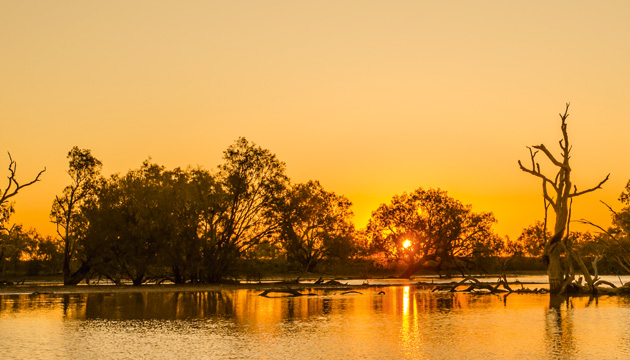An outback treasure-trove of Australian storytellers, the Back o’ Bourke is writing a bright new chapter.
Story + Photos Mandy McKeesick
They’ve been writing stories about this area for so long the term Back o’ Bourke has become part of the Australian vernacular. Dictionaries define it as a very long way away; a remote inland area; the middle of nowhere. It is rumoured to be the home of the legendary Speewah, a mythical station, where tall tales bred faster than the rabbits and where the equally legendary Crooked Mick was said to have had his legs ringbarked by his father in order to slow a growth spurt.
In a conventional sense, the Back o’ Bourke is best defined by water – or the lack of it. It is hemmed by ephemeral rivers: in the north-east, the remote Narran, Bokhara and Culgoa rivers flow through coolibah floodplains; at Brewarrina the Barwon creeps past ancient Aboriginal fisheries and turns into the Darling at Bourke, where paddle-steamers once plied their trade on what was known as the second Mississippi. To the west, the Warrego and the Paroo flow, when it suits them, to spread upon the flat land or, in the wettest of years, to join the Darling on a journey to South Australia. Between the rivers are depressions, which transform into wetlands of international significance when water is added: the freshwater Lake Numalla and its saltwater neighbour Lake Wyara, and the Cuttaburra Channels – home to thousands of birds if it rains.
The highs and lows of the waters reflect the ebbs and flows of this country, where droughts and flooding rains produce a landscape of extremes. It has an enduring Indigenous heritage, with myriad groups calling it home, and when the new Australians came it was on the sheep’s back. By the 1890s Bourke was a major inland port and three steam-driven cranes on the wharf handled 40,000 bales of wool a year, sending their riches, via the Darling, to southern markets. Later, schemes and dreams were realised as water was used for irrigation, which brought with it controversy that persists today.
Bourke, with a population of 2600, is the economic hub of the area, supporting livestock, irrigation, tourism and commercial industries. Other towns and villages of note include Brewarrina, Enngonia, Wanaaring, Louth and Hungerford, and, if you’re looking for a cold beer and not a lot else, there are pubs at Byrock and Ford’s Bridge, but the one at Barringun recently burnt down.
This story excerpt is from Issue #118
Outback Magazine: April/May 2018









